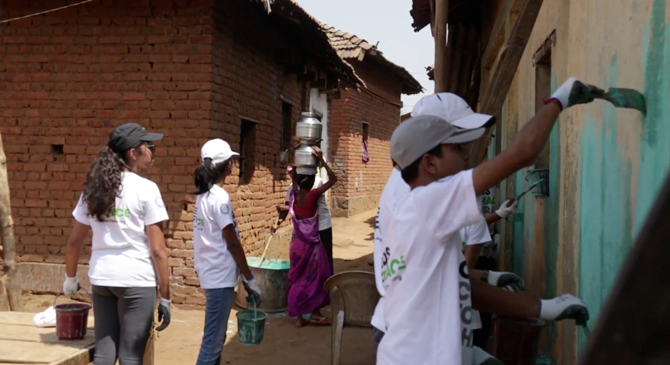So much of what we do aims to broaden perspectives and cultivate empathy. Whether in dialogue huts at Camp or at regional convenings, our work provides a transformational experience for young leaders eager to bring change in their communities.
But sometimes, people need to see that they’re making an impact in tangible, physical ways. They need to lead change with their hands, as much as with their hearts.
So this spring, we packed 64 Seeds, incoming campers, and other program participants onto a bus and drove out of Mumbai as far as the road would take us, to where the tar ended and earth began. We got out, bottles of water in hand, and trudged down a sun-dried mud path until the bus shrank on the horizon behind us. We had reached a remote village outside Karjat, where we would take part in our annual Young Leaders Build.
For the past several years, we have organized this event in partnership with Habitat for Humanity, which builds houses for families in underserved communities. The families are equal stakeholders in the construction of these houses, from planning the layout, to baking the bricks used to build them, to laying the foundation. The houses, when completed, are deeded to the family matriarchs to promote gender equity.
Our volunteers begin working once the foundation has been laid and the first stages of brickwork have been completed. Their tasks can range from painting to erecting additional walls to connecting the frames, and much more.

Our participants always value the opportunity to interact with the families and feel like they’re doing something tangible about the housing crisis in India. It’s a real challenge, and this is a real solution being met with real efforts by our community.
But our goal isn’t just to help build houses for those in need. This activity is a remarkable springboard for dialogue.
Before the build starts, we ask the participants what their intention is in coming here. Is this something they are thinking of just doing once, or will this be a gateway to volunteering more in their community? Is there something specifically that they want to achieve here, and if so, what is that? Are they here out of pure altruism, or are they here in part for their egos?
As they build, we also ask participants be mindful of whether they feel connection to the people they are building with, the people they are building for, and the land they are building on. And afterward, we ask them to reflect on the questions this work raised about their own identities.
Privilege often comes up in these reflections; some participants feel guilty that they come from a higher socioeconomic background than the villagers. Just like in Camp, the Youth Build offers an opportunity to meet the “other” face-to-face, work alongside them, and hear their stories. For some, this will be the first time in their lives when they truly reckon with disparity in our society.
“Building someone’s first house made me realize that I have so much, more than I can ever imagine,” one participant realized. “But instead of being grateful for it, or simply acknowledging it, at times I catch myself complaining about the pettiest of the things.”
This invites another question I hope each participant takes away from the Youth Build: what is the definition of privilege? Is it just money and social class? Or are these villagers—with their their lack of traffic, their tight-knit community, their unpolluted air—privileged in a different way?
Not that they are immune to the side effects of our relationship with the environment. Accessing clean drinking water, in particular, is a huge challenge for these villagers. And so we also ask participants what our own culpability is in the hurdles that these people face. When we have to bring in bottled water by foot for our volunteers as they toil under the hot sun, they experience firsthand what the costs of living unsustainably are, and how it disproportionately affects poorer areas. When we talk about peace, we also have to talk about peace with our environment, with nature.
None of this seems to have put a dent in our volunteers’ excitement. One moment that struck me this year was how infectiously eager they were. They wanted to keep building more and more, and I found myself constantly asking them to take it easy and be mindful of the heat. We practically had to pull them off the houses at the end of the day.
The other moment that left me humbled was the way our participants reached out to the villagers. It was so much more than simply working together with them to build houses. Our volunteers were really engaging with the families and children; they wanted to hear their stories and learn from their wisdom. I thought to myself, this is what all the work we do to cultivate empathy looks like in action. Our volunteers were as touched by the experience as I was by their enthusiasm.
Ultimately, it’s the human connection they cultivate, and their desire to pay it forward, that brings us back year after year.

